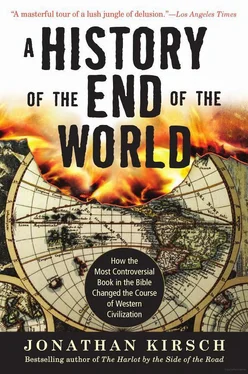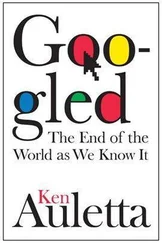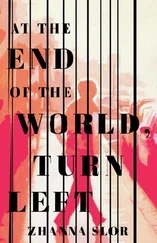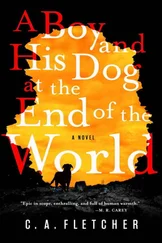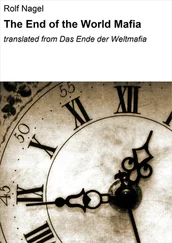The name that Vernon Howell chose for himself is dense with biblical meanings. The first name, of course, was meant to remind the Branch Davidians of the biblical king of Israel whose blood is said to have flowed in the veins of Jesus: “Lo, the Lion of the tribe of Judah, the Root of David,” writes the author of Revelation, “has conquered, so that he can open the scroll and its seven seals.” 105And “Koresh” is the Hebrew name of the Persian emperor, Cyrus, who permitted the exiled Jews to return to Judea and rebuild the Temple in Jerusalem, thereby earning for himself the biblical title of “Messiah.” Thus did Vernon Howell make a coded claim to his own messiahship.
Like Houteff, David Koresh was convinced that he alone was capable of retrieving the hidden secrets of the Bible, especially the meaning of the seven seals of Revelation. Like Jan Bockelson, he prescribed a strict code of sexual morality that applied to everyone but himself, and he openly snacked on forbidden foods like ice cream and candy while his followers were confined to a vegetarian diet “whose rules about food combination changed frequently.” Like Father Miller, he engaged in the dangerous practice of date setting. The Tribulation, Koresh predicted, would begin in 1995, exactly ten years after his “coronation” as leader of the Branch Davidians. 106And, like the author of Revelation, he insisted that he had been “taken up into the heavens by angelic beings,” which Koresh described as “a ‘spaceship’ that ‘travels by light, the refraction of light.’” 107
Koresh was convinced that the world was witnessing the fulfillment of the prophecies that are expressed in Revelation as the breaking of the seven seals. He understood his own calling to the leadership of the Branch Davidians as the prophecy of the first seal: “And I saw, and behold a white horse: and he that sat on him had a bow; and a crown was given unto him: and he went forth conquering, and to conquer.” 108By 1992, Koresh had come to believe that one of the spookiest and most unsettling prophecies in the book of Revelation, the opening of the fifth seal, was imminent:
And when he had opened the fifth seal, I saw under the altar
the souls of them that were slain for the word of God,
and for the testimony which they held:
And they cried with a loud voice, saying, How long, O Lord,
holy and true, dost thou not judge and avenge our blood
on them that dwell on the earth? 109
David Koresh might well have lived out his life in obscurity as a self-appointed “prophet” if he had not also embarked on a fateful plan to arm the Davidians with automatic weapons. He had already amassed an arsenal, and now he began to purchase the kits that would enable him to convert a cache of semiautomatic rifles into weapons with a far greater rate of fire. That’s why agents of the U.S. Bureau of Alcohol, Tobacco and Firearms began to take an active interest in what was happening inside the compound at Mount Carmel. On February 23, 1993, federal agents launched an abortive raid, the beginning of a siege that lasted fifty-one days and ended only with a final conflagration that burned Mount Carmel to the ground and cost the lives of more than eighty Branch Davidians, including Koresh himself.
At one point during the siege, the FBI was given some curious but insightful advice by a pair of professors of religion who insisted that a close reading of Revelation held the key to ending the standoff with the heavily armed Davidians. Koresh was apparently convinced that the Davidians were the ones destined to be “slain for the word of God” when, according to Revelation, the fifth seal is broken. But the two scholars sought to persuade Koresh, by means of a radio broadcast, that he should read and heed the very next line in the book of Revelation: “And it was said unto them, that they should rest yet for a little season.” 110If Koresh could be convinced that “God intended the ‘little’ season to last until after the end of the siege, giving him time to stand trial and then resume a worldwide ministry,” explains Damian Thompson, “then the standoff would end peacefully.” 111
FBI negotiators, in fact, took the advice seriously enough to play a tape of the radio broadcast over the telephone for Koresh, and he reportedly agreed to abandon his stronghold at Mount Carmel once he had composed his own treatise on the meaning of the seven seals. But the FBI was not willing to wait long enough for Koresh, who was capable of sermonizing at extraordinary length, to complete his latest exegesis. “[T]hey were unfamiliar with religion’s ability to drive human behaviour to the point of sacrificing all other loyalties,” explains Thompson, writing of an era when the world did not yet fully understand what motivates suicide bombers. 112
The role of Revelation in the siege of Mount Carmel was mostly overlooked at the time it was taking place, and entirely forgotten thereafter. The whole sorry affair has been written off as an unfortunate encounter between overeager law-enforcement agents and overzealous religious cranks, all of whom were spoiling for a shoot-out. But the tragedy would never have taken place—and the Branch Davidians would not have come into existence at all—but for the strange power of the apocalyptic idea. The book of Revelation carries some “dangerous baggage,” as we have seen already and will see again, and even the brightest and shiniest dreams of a new heaven and a new earth have a dark side.
Consider, for example, the remarkable media phenomenon known as the Left Behind series, which exploded into American popular culture even as the ugly memories of Waco were beginning to fade away.
When Tim LaHaye published a tract titled The Beginning of the End in 1972, he was yet another hard-preaching doomsayer who urgently sought to persuade his readers that the end of the world was nigh. Indeed, he offered a strong dose of dispensational premillennialism that differed not at all from what John Nelson Darby or Father Miller preached in their own day. “[W]e could well be the generation that sees the culmination of the ages and the ushering in of the Kingdom of Christ,” he writes. “Certainly we have more historical evidence for such a possibility than any generation of Christians in almost 2,000 years. In fact, I believe the Bible teaches that we are already living in the beginning of the end.” 113
By 1995, however, LaHaye put himself in a very different place on the cultural landscape when he penned (with coauthor Jerry B. Jenkins) a slick apocalyptic thriller titled Left Behind. The message is exactly the same, but the medium is wholly different. Styled as a contemporary potboiler, Left Behind features the stock characters, exotic settings, and fast-paced plot that we would expect to find in a best seller by Robert Ludlum. Aside from the fact that Left Behind was published by Tyndale House, a leading publisher of fundamentalist Christiantitles, nothing on the front or back cover reveals that it is actually a thinly disguised theological tract. But the very first passage slyly introduces the reader to the doctrine of the Rapture when the hero, a commercial airline pilot called Rayford Steele, discovers that half of the passengers on his Boeing 747 have somehow exited the aircraft in midflight.
“I’m not crazy! See for yourself!” screams a distraught flight attendant. “All over the plane, people have disappeared.”
“It’s a joke. They’re hiding, trying to—”
“Ray! Their shoes, their socks, their clothes, everything was left behind. These people are gone!” 114
Thus began a sensationally successful media enterprise that demonstrates the power of the apocalyptic idea in its purest and simplest form. The Left Behind series, a protracted account of the Tribulation and the antics of the Antichrist, spawned not merely a string of novels but a multimedia empire, including books, comics, newsletters, audios, videos, and a Web site called “The Left Behind Prophecy Club.” Significantly, the publisher spun off a separate series especially for young readers, titled Left Behind: The Kids, which now consists of an additional forty titles. While Hal Lindsey was hailed as the best-selling author of the 1970s for selling 20 million copies of The Late Great Planet Earth, the Left Behind series has reportedly sold more than 50 million copies since the first title was published in 1995. And the end—surely to the disappointment of its authors—is nowhere in sight.
Читать дальше
